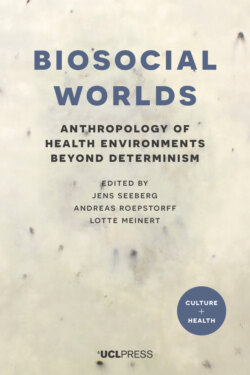Читать книгу Biosocial Worlds - Группа авторов - Страница 25
На сайте Литреса книга снята с продажи.
Food as environment
ОглавлениеGlobally, nearly 2 million children die from malnutrition each year. Research has revealed significant findings about biological differences between infants who suffer from marasmus as opposed to kwashiorkor2 (Forrester et al. 2012). This impressive study carried out in Jamaica commenced in 1962 and continued for 30 years; during this time over 1,100 infants with severe acute malnutrition were admitted to University Hospital, Kingston. It was found that those infants diagnosed with kwashiorkor had considerably higher birth weights than did infants diagnosed with marasmus. The authors concluded that mechanisms associated with physiological ‘plasticity’ are operative in utero and that these children have distinctively different types of metabolism. Of the two conditions, children more often die from kwashiorkor, associated with edema, although less wasting takes place as compared to marasmus. Children diagnosed with marasmus do not become edematous, but endure much greater wasting of their flesh, although their survival rates are better than those of children with kwashiorkor.
Researchers characterise marasmus as ‘metabolically thrifty’, and kwashiorkor as ‘metabolically profligate’. They propose that in the case of children with marasmus, when the maternal diet is low in nutrition, fetal metabolism in utero in effect ‘anticipates’ a postnatal environment of scarcity, and low birth weights are assumed to be evidence of this process designed for survival. The authors argue that this finding provides the first direct evidence in humans in support of the fitness-enhancing effects in childhood of ‘anticipatory responses’ in utero. Hence, the distinctly different phenotypes of children with kwashiorkor and marasmus are understood as the endpoints of epigenetic activity on genotypes in utero.
Nutritional epigenetics is a field attracting a great deal of attention in part because it is hoped that it will throw light on the so-called obesity epidemic currently affecting many countries, whether affluent or not. The same team that carried out the research reported above argues that growing evidence exists of ‘developmentally plastic processes’ that, in addition to lifestyle and individual genotypes, contribute significantly to obesity (Forrester et al. 2012). No claim is being made that such developmental pathways in which methylation processes are involved cause obesity directly, but that the risk of individuals genetically predisposed for developing obesity in later life is increased.
Based on a hypothesis known as the ‘mismatch pathway’, it is posited that ‘evolved adaptive responses of a developing organism to anticipate future adverse environments’ can have maladaptive consequences if the environment is not what has been ‘biologically anticipated’. In other words, if fetuses and young infants are exposed to nutritionally deprived diets, their bodies may be epigenetically prepared to deal with deprivation as they mature, as the marasmus study suggests, a situation that can cause havoc in energy-rich environments. In addition, maternal diabetes, maternal obesity and infant overfeeding are associated with increased risk of obesity in adult life (Gluckman and Hanson 2006). Clearly this account resembles the thrifty gene hypothesis put forward in 1962 by James Neel, an argument now outmoded in the post-genomic era; discussion about thrifty phenotypes has superseded it (Watve and Yajnik 2007).
Hannah Landecker argues that researchers presently understand food as an ‘epigenetic’ factor that functions in the regulation of gene expression, in turn, linked to several medical conditions including cancer, metabolic syndrome, obesity and diabetes. In other words, food is a form of ‘environmental exposure’ (Landecker 2011, 167) in which the environment is molecularised as food chemistry so that ‘the body’s molecules [are] hung in the same network of interactions as environmental molecules, a network anchored and organised through the temporarily sensitive interface of metabolism’ (Landecker 2011, 176). Landecker argues that this is a model ‘for how social things (food, in particular) enter the body, are digested, and in shaping metabolism, become part of the body-in-time, not by building bones and tissues, but by leaving an imprint on a dynamic bodily process’, namely, the expression of genes (Landecker 2011, 177).
